CASCADIA STORY
by
Mona Hyer Waibel
All photos are from the personal collection of Mona Hyer Waibel. Use of them for commercial purposes is prohibited without her permission.
![]()
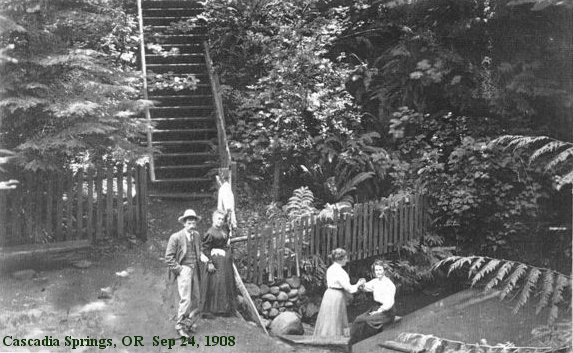 Cascadia has long been a fine place to
visit on summer days, and it�s also been a good community to live in for many
years, though it once had more residents than it does today.
Cascadia has long been a fine place to
visit on summer days, and it�s also been a good community to live in for many
years, though it once had more residents than it does today.
Over the
years, there have been several interesting places to visit in Cascadia,
including a health resort, a fine hotel, healing mineral springs, swimming
holes, the Indian cave, beautiful waterfalls and a covered bridge. These all
have made Cascadia an appealing spot to live and
visit.
On the way across the Cascade Mountain
Range, early travelers by horseback or wagon needed housing for the night and,
of course, shelter and feed for their horses. It took one day to travel from
Sweet Home to Cascadia, and another long day to reach the popular Mountain
House. The location of the Mountain House changed through the years, but it was
a popular stop for decades for travelers over the
It was in 1895 that my two grandparents
met. Grandmother Lettie Thompson taught during the school year and in summers
she worked at the Mountain House cooking for travelers. My grandfather, Andrew Jackson Daugherty, was
herding sheep over the pass and stopped at Mountain House for dinner and to
spend the night. He must have been very
smitten with Lettie; they married within the year.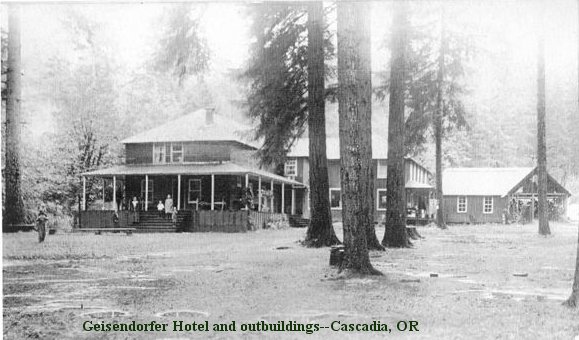
Later, as
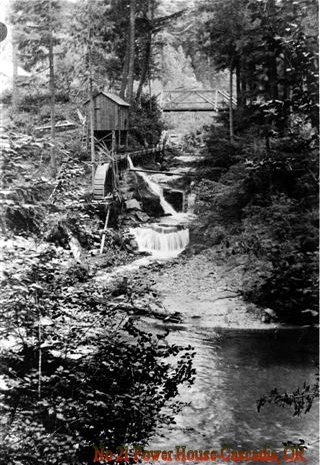
After the
My
great-grandparents, the John Thompson family, filled their jugs with the mineral
water and took them home to drink and to make their pancakes and breads, too.
Through the years, thousands enjoyed coming to the
Let�s back up a few years. Travelers needed a way to cross the
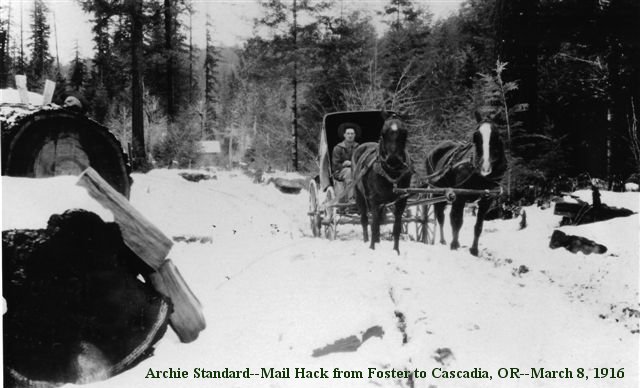
Travelers were charged a toll to use the
rough wagon road. John Gilliland was the
first tollgate keeper west of the summit.
Jake Nye followed, and son Marvin Nye (Marvie, as he was known) followed
Jake. The first gate was located in Foster, then moved to Wiley Creek out of
Foster; then to Cascadia, and finally to White City, near Cascadia. People resented paying the toll charge and
tried tricking the gate keeper by distraction. Marvin Nye was successful in
developing fire protection service for safety and preservation of our valuable
timber holdings in the
Ernest Billings ran a stagecoach from
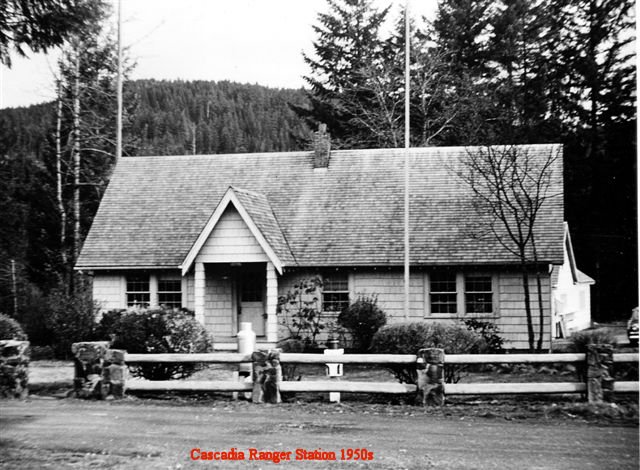
Many milestones brought change. The
Cascadia Ranger Station, located at the intersection of
Twenty-three years of efforts by locals
brought about the completion of 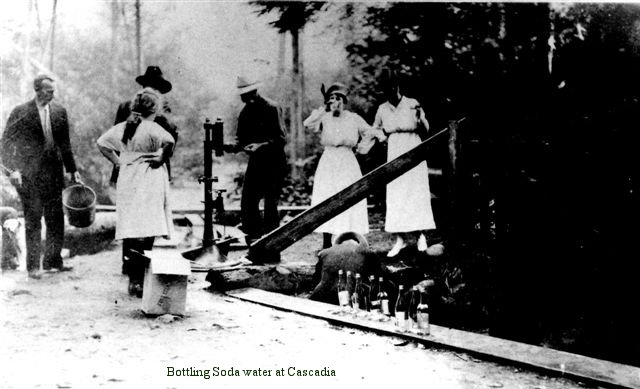
Everyone used the same metal ladle and it
never disappeared. Later, the area was covered with cement and the pumps were
replaced with concrete lids to cover the soda wells. We just moved the lids and
carried our own cups to dip into the fizzy soda water. The minerals stained
areas of the concrete to a yellow rusty look.
We drank deeply and filled our cup over and over until we could hold no
more. Later, a sign was erected that
read �water contaminated and unfit for human consumption.� I have been told the
water is OK, but the state quit letting people drink
it.
Campsites and trails were developed in
the park as well as ball fields. Huge parking areas were available for all the
cars. A cable was placed across the road into the park�s picnic area until the
park was open for the season. But the park was always open for a hike. A popular trail led visitors to tall
waterfalls, cascading cool waters that sprayed hikers. Once in a while, trees
would fall across the path and we had to climb over the
trees.
Over the years, campsites have been
installed for overnight stays, along with flush toilets and, eventually,
showers. It was a grand place to spend a
thrifty family vacation, and
Another mile-long trail along the banks of
Hill Timber owns the land containing the
Indian rock shelter and an agreement has made it available for park explorers.
Hopefully, the
Visitors
came to see covered bridges all around the
In the early
`70s,
Amos Horner feared his Cascadia Lumber
Company mill would need to be moved. Employees were concerned for their jobs.
Storms of protest came from
Back in town,
According to Jean Horner Burger,
attending
The long drive in winter conditions was
difficult for teachers and not many teachers applied, even though Cascadia was
the richest district in the local area. They had the finest gym, a trampoline,
parallel bars and fine principals teaching.
Gil Little was principal for several years, with
Don Hopkins serving as the final principal. In 1965 the school district unified,
and eventually
The unused school building became a
rehabilitation site for Indians needing help with alcohol consumption � the
isolation contributed to patients� treatment.
Sweat lodges built from fresh-peeled logs housed unusual activities.
Several times we Waibels were invited to join an
Indian feast, bonfires, of corn roasting over coals, with spicy sausages on
sticks. Indian chants with drums were entertaining. Today, the remodeled old
school building has an attachment, the Cascadia U.S. Post
Office.
Amos Horner, mentioned above, was a creative, unforgettable man. In the beginning of his career, he welded together a portable sawmill, hauling it into the forests. His business kept growing as the demand for more lumber increased. He once paid workers in silver dollars and watched them flow into our community; another time it was $2 bills. The cash registers of stores, the churches' collection plates, the taverns etc. all felt the impact of what Horner's mill provided in salaries. During 1970s gasoline shortage, Amos bought a gas station to ensure his workers had fuel. The TOMCO mill, (the name stood for "Try Once More Company"), worked well for years. Later, Triple T Studs in Cascadia provided many jobs as the Stock family, with Mike Horner, kept the Cascadia mill going. Triple T Studs ("Try the Third Time") sadly closed in August 2006. Both Amos and Dorma Horner died in 2000. Amos made many contributions to Cascadia and the Sweet Home area.
Note: In August 1 1983 Amos & Dorma Horner, Mr & Mrs Charles Cutting, Mike Horner, Mr. & Mrs Lonnie Horner, Jean & Kevin Burger were the original Stockholders, builders and operator's of Triple T Studs Inc. They were joined on September 15, 1984 by Wynn & Candy Gilbertson ,& Leif & Dawn Gilbertson in the venture. The original intent was to have a family owned and operated Stud Mill Business that would run when the market was good and lay idle when the market was down. The Stocks and brother Mike Horner bought out the Stockholders July 9, 1990. Contributed by D.Jean Burger
During the 1960s and
`70's, Cascadia
changed, becoming our own
Yes, Cascadia survived many changes and it
has continued to be an extraordinary place to live and visit.
![]()
My name is Stephenie Flora. Thanks for stopping by. Return to [ Home Page ] All [ Comments and Inquiries ] are welcome.